Whenever I’m speaking about or conducting basic SharePoint user training, there is usually some confusion surrounding the use of pages vs. sub sites. I frequently get questions like “What is the difference between a sub site and a page?” and “When should I use a page vs. a sub site?”
In this post I will explain the difference between SharePoint sub sites and pages, how the global top navigation bar is affected by both of these objects, and a checklist in deciding which option you should choose when building out your SharePoint site.
What is a page?
A page is basically an area to display content to users, such as images, hyperlinks, lists, libraries, web parts, and text. This content can be arranged and organized in whatever way the page creator chooses. The content area of a page is what you see below and to the right of the navigation elements of SharePoint.
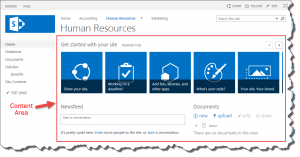
What is a sub site?
A site is a container of objects which can include lists, document libraries, and pages. A site can also contain nested sites called sub sites. Sometimes the terms site and sub site are used interchangeably. They are essentially the same thing, as a sub site is just a site that lives underneath another site.
Every site has at least one page, which would be the home or landing page. Additional pages can be added to the site by users.
How do pages and sub sites affect navigation?
The impact that a sub site has on the site’s navigation is dependent on whether the publishing feature is turned on.
If publishing is turned off, then you will need to either tell SharePoint that you want the sub site to appear in the global top navigation upon creation, or you can also add it manually later.
If the publishing feature is turned on, then you simply need to make sure that displaying sub sites automatically in the top navigation is enabled. To do this, open the site actions menu and click site settings.
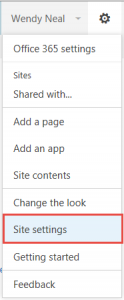
Click the navigation link under the look and feel section.

Make sure that structural navigation is chosen and that the Show subsites box is checked in the global navigation section.
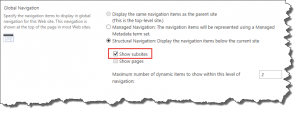
You can also create a complete hierarchy of pages in your top navigation if you wish, however you’ll have to create those links manually. You will see how to do that below in the creating a page section.
Creating a sub-site
Let’s say that we have a Human Resources site, and under that site we want to create a self service area for employees to be able to update their contact information, request changes to their payroll information, request time off, etc. There will likely be several supporting lists and libraries that will need to be created in order to serve all this functionality. We want this self service area to be a dropdown menu link in the top navigation under the HR site. Also there may be different people within the HR team administering this site than the rest of the HR site, so it may require different permissions.
In this case I would create a sub site in order to keep all this supporting information together, and to keep the permissions administration clean.
To create a sub site, click on the site settings icon, then site contents.
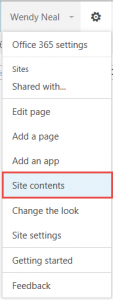
Scroll to the bottom of the page and click new subsite.
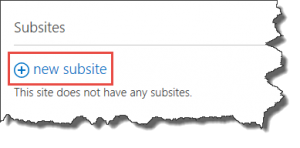
Give your site a name and address and select a template.
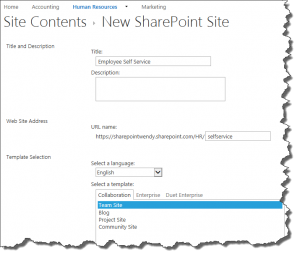
Scroll to the bottom of the page and click create.
After you’ve created your sub site, notice that a link to it now automatically displays on the top navigation bar below the Human Resources site (if you have publishing enabled).
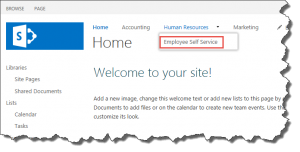
Creating a Page
Using our Human Resources site example, let’s say we wish to create an area to display benefits information to the users. It will be a simple list that contains the contact information to all of the companies that provide benefits for the company – health insurance and life insurance providers, etc. It will also have a library that stores the supporting documents for all the benefits. There are no special permissions needs around the list or library.
In this case I would create the list and library at the top level of the HR site and then create a page to display both of these in the form of web parts.
To create a page, click on the site settings icon, then add a page.
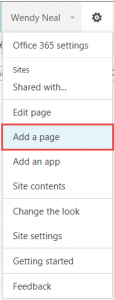
Give your page a name and click create.

This creates a blank page opened up in edit mode, ready for you to add content.
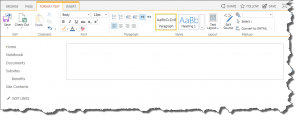
After you have saved your page, you’ll need to manually place a link to it in the top navigation. Click EDIT LINKS next to the top navigation links.

Click the + link button.

Type in the name of your page and the relative address to the page (the relative address is the portion of the URL after the domain, including the leading forward slash) and click OK.
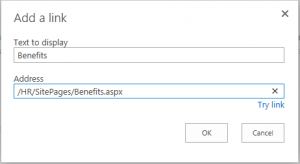
This will place the link at the top level, so you’ll need to click and drag the link underneath the Human Resources site, and then Save. Now you will see your link to your page like this:
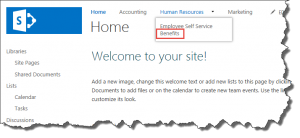
Summary
Pages and sub sites are different ways of organizing and displaying information to your users. They each affect the navigation of your site in different ways, and depending on whether the publishing feature is turned on, could even make building the global top navigation bar completely effortless for you.
As to whether you should create a sub site or a page, the list below suggests that you should use sub sites when any of the following are true:
- You need several supporting lists and libraries and wish to encapsulate them in their own area
- You have separate permissions needs for a group of related information
- You don’t want to manually create or manage top navigation links (if publishing feature is enabled)
Otherwise a page will suffice.
To find out more about this or other ways that RSM can assist you with your SharePoint needs, contact McGladrey’s technology consulting professionals at 800.274.3978 or email us.

 RSMUS.com
RSMUS.com